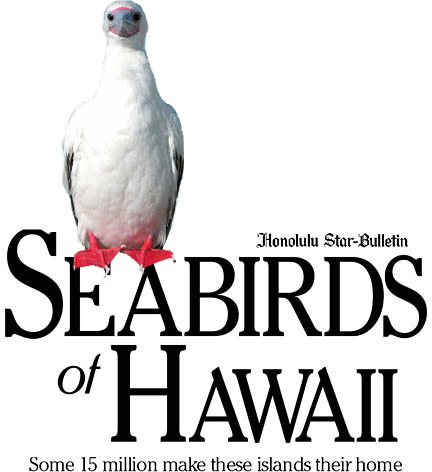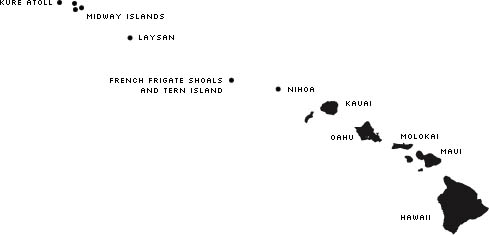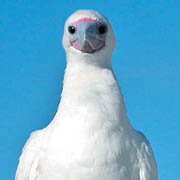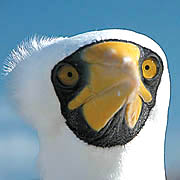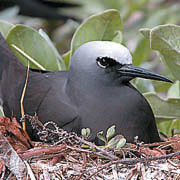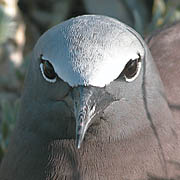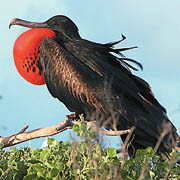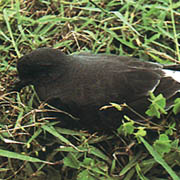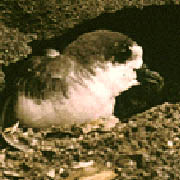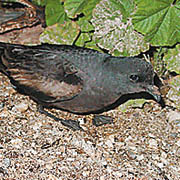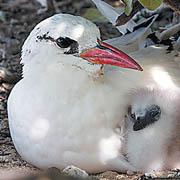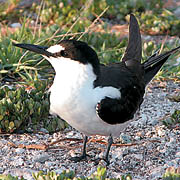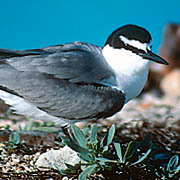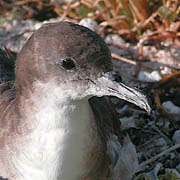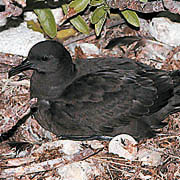
An estimated 15 million seabirds of 22 species are either flying over Hawaiian waters or breeding on Hawaiian islands at any one time. Still, these birds can be hard to spot because their true home is the open ocean.
Seabirds are made for life on the ocean, gliding on the wind, drinking sea water and eating fish and squid. Some birds remain at sea for years at a time, spending most of their time on the wing.
Hawaii's seabirds are scarce around human-inhabited islands because most are ground-nesters and are therefore prey for cats, rats, dogs, mongooses and people.
Of Hawaii's 22 species, two are found only in Hawaii. These seabirds -- the dark-rumped petrel and the Newell's shearwater -- breed only in the main islands and are listed under the Endangered Species Act. Most of Hawaii's other seabirds breed in the predator-free islands of the Northwest Hawaiian Islands chain.
The majority of seabirds mate for life and return to the same area each year to raise their young. Males and females of most species look similar. Both share parenting duties.
Seabirds have lost most of their nesting grounds in the main islands and were once hunted for their feathers and eggs. Today, all species are protected by federal and state laws.
Red-footed booby
Sula sula ~ 'A
These birds nest in shrubs and trees, perching on branches with their bright red feet. The Kaneohe Marine Corps Base Hawaii and Kauai's Kilauea Point host red-footed booby colonies. This booby is one of the most frequently spotted near the main islands.
Wingspan: 40 inches
Black-footed albatross
Phoebastria nigripes
These birds' tendency to follow ships gets them in trouble. As baited hooks unroll off longliner fishing vessels, the albatrosses snatch them, get hooked and drown. This species is listed as endangered by the International Union for the Conservation of Nature.
Wingspan: 76-84 inches
Laysan albatross
Phoebastria immutabilis ~ Moli (Hawaiian name)
You can see these big birds nesting now at Kaena Point Nature Reserve. Because chicks in their ground nests are helpless, dogs are not allowed there. The offspring of both albatross species spend their first five years at sea.
Wingspan: 80 inches
Brown booby
Sula leucogaster ~ 'A
Because these birds like to sit on navigational buoys and other floating objects, they are the easiest of the booby birds to spot around the main Hawaiian islands. Brown boobies are common on leeward coasts and forage closer to shore than other Hawaiian seabirds.
Wingspan: 54 inches
Masked booby
Sula dactylatra ~ 'A
This is the largest and least common booby in main island waters. All boobies dive from great heights to catch fish and squid.
Wingspan: 60 inches
Black noddy
Anous minutus ~ Noio
Black noddies nest in coastal caves and on rocky ledges on the main Hawaiian islands. They are common near the cliffs of Hawaii Volcanoes National Park. In the Northwest chain, these birds build nests in shrubs and trees.
Wingspan: 28 inches
Blue noddy
Procelsterna cerulea
Blue noddies breed on rocky ledges of the Northwest chain and stay there year-round. They eat water-striders and other invertebrates from the ocean's surface. Adult noddies of all species bow, or nod, to one another in the colonies, like the blue noddy at left. No one knows the meaning of this polite-looking gesture.
Wingspan: 18 inches
Brown noddy
Anous stolidus ~ Noio koha
Unlike black and blue noddies, browns lay their eggs on the ground on the main islands' offshore islets and in the Northwest chain.
Wingspan: 33 inches
Great frigate bird
Fregata minor ~ 'Iwa
Male frigate birds have red throat pouches that inflate during courtship. Females have white throats and chests. These birds are notorious for stealing food on the wing from boobies and shearwaters. Frigate birds, however, also catch their own fish.
Wingspan: 90 inches
Bonin petrel
Pterodroma hypoleuca
These birds nest in the Northwest chain and arrive at their burrows at sundown. Their nighttime mating calls are moans and squeaks.
Wingspan: 31 inches
Band-rumped storm petrel
Oceanodroma castro ~ 'Ake'ake
Also called Hawaiian storm petrels and Harcourt's storm petrels, this species is rare in Hawaiian waters but is widespread throughout the Atlantic and Pacific oceans. Little is known about these birds in Hawaii. They are thought to nest in Kauai's mountains.
Wingspan: 17 inches
Bulwer's petrel
Bulweria bulwerii ~ 'Ou
These small birds nest on offshore islets of the main islands and fish nearby. They fly and hunt with wedge-tailed shearwaters. Their call resembles a softly barking dog. All of Hawaii's petrels are active at night.
Wingspan: 23 inches
Dark-rumped petrel
Pterodroma phaeopygia sandwichensis ~ 'Ua'u
Also known as the Hawaiian petrel, this endangered species is native only to Hawaii. The birds' last main nesting grounds are Haleakala Crater and some high-elevation sites on Kauai, but a few nest on other main islands.
Wingspan: 36 inches
Tristram's storm-petrel
Oceanodroma tristrami
These storm petrels nest in Hawaii's Northwest chain but are uncommon. Storm petrels are hard to identify at sea. They are small, fast and mostly black.
Wingspan: 22 inches
White-tailed tropic bird
Phaethon lepturus ~ Koa'e kea
These birds have two streaming, white tail feathers. They nest on coasts and in valleys of all the main islands. It is common to hear the harsh, braying calls of tropic birds on the cliffs above the road to Kaena Point.
Wingspan: 35-38 inches
Red-tailed tropic bird
Phaethon rubricauda ~ Koa'e'ula
These birds nest on Manana Island (off Sea Life Park) but are usually hard to spot in the main islands. The best place to look for these birds is at Kauai's Kilauea Point. These tropic birds have two long, red tail feathers and a harsh, raspy call.
Wingspan: 44 inches
White tern
Gygis alba ~ Manu-o-ku
Commonly called fairy terns after their fluttery flight and big, black eyes, these are the only seabirds that nest in Honolulu. In some areas of the city, it's possible to spot parents carrying small fish in their bills to feed their chicks.
Wingspan: 28 inches
Sooty tern
Sterna fuscata ~ 'Ewa'ewa
Infamous for their shrieking calls, day and night, these birds are the most numerous of Hawaii's seabirds. It is said that Alfred Hitchcock used sooty tern screeches in his horror film "The Birds."
Wingspan: 34 inches
Gray-backed tern
Sterna lunata ~ Pakalakala
These less boisterous and less numerous cousins of sooty terns, below, often eat juvenile cowfish. It's common to find those fishes' hard exoskeletons in abundance around gray-back breeding grounds.
Wingspan: 29 inches
Wedge-tailed shearwater
Puffinus pacificus ~ 'Ua 'u kani
Nesting "wedgies" are common on main island coasts, offshore islets and in the Northwest Chain. These birds' mating calls sound like agonized moaning. To find tuna, anglers look for flocks of feeding shearwaters. These birds feed on small fish driven to the surface by tuna.
Wingspan: 38 inches
Newell's shearwater
Puffinus newelli ~ 'A'o
These seabirds are famous for nesting on Kauai's mountain slopes. Chicks trying to fly to the ocean often get confused by city lights and land on highways. Each year, Kauai residents help biologists save about 2,000 downed birds.
Wingspan: 30-35 inches
Christmas shearwater
Puffinus nativitatis
Named after Christmas Island where they also breed, these birds are sooty black in color and smaller than their more common wedge-tailed cousins. They nest in small numbers on Moku Manu Island off the Mokapu Peninsula, but most are found in the Northwestern Hawaiian Islands.
Wingspan: 32 inches
— ADVERTISEMENTS —
— ADVERTISEMENTS —
